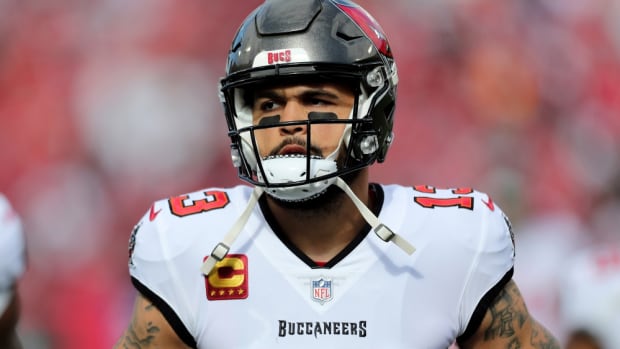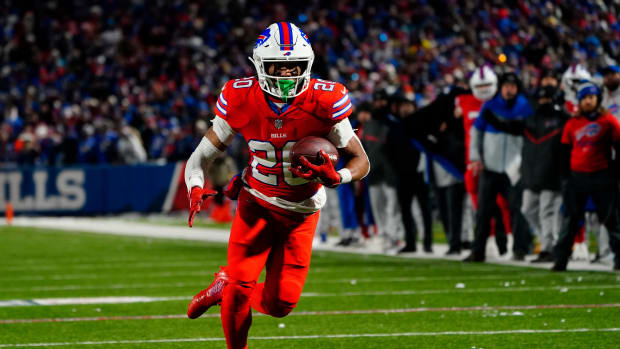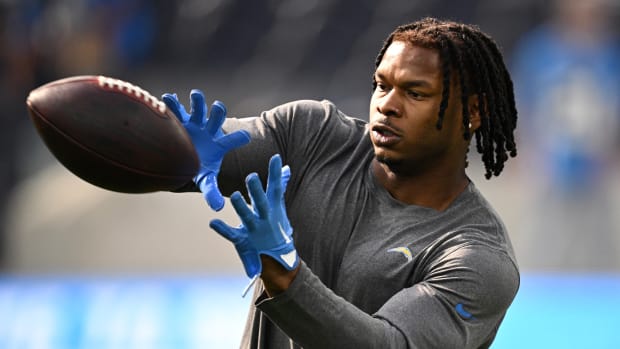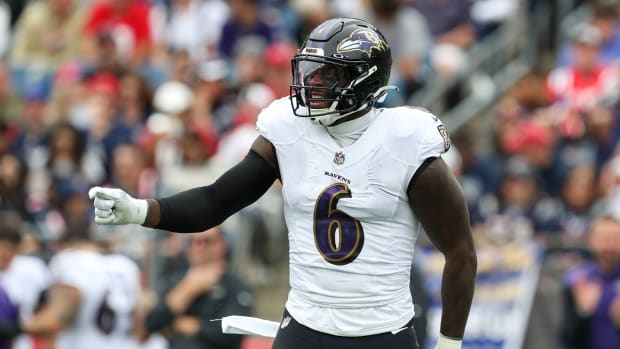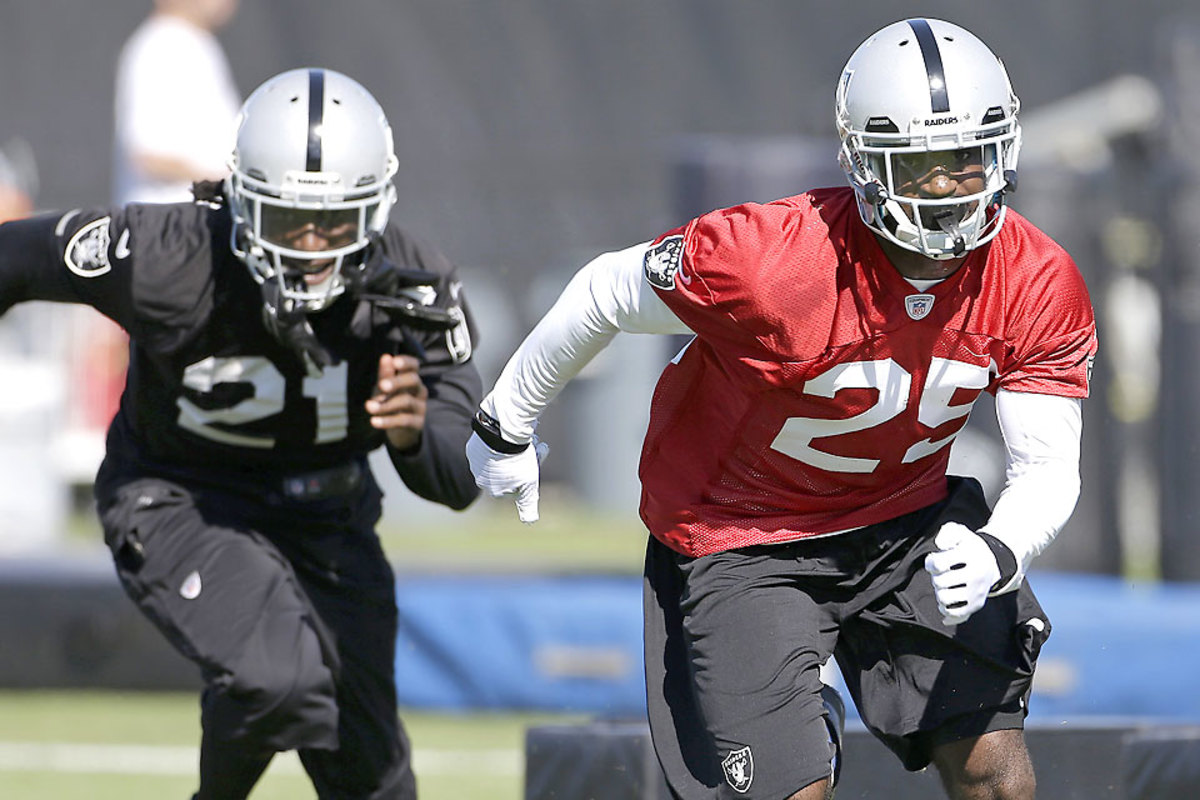
Raiders Preview: Construction Zone
Back in June, members of the media climbed the mountaintops and shouted their disgust over the firing of Raiders public relations director Zak Gilbert. In the post-Al Davis years, Gilbert had transformed the NFL’s least accommodating PR department into one of its better ones. But after a story by SI’s Jim Trotter added to the mounds of anecdotes about the franchise’s dysfunction in Davis’s final years, a wounded Mark Davis impetuously canned Gilbert, looking every bit like his father’s son. The media’s outrage seemed nine-tenths derived from its support for Gilbert—who has since become the Browns’ director of communications—and one-tenth from its disappointment in the mere thought of the once-proud Silver and Black still being stuck in their unstable ways.
After Al Davis died in October 2011, Mark—who admittedly doesn’t share his father’s insatiable passion for football—enlisted the help of John Madden and Ron Wolf in searching for a general manager. He landed on Packers director of football operations Reggie McKenzie, who has spent his first year and half on the job trying to set the franchise back on the right track.
This past offseason, McKenzie’s efforts brought about a roster purge that piled up an astounding $49 million in dead money for 2013. That’s $49 million of the team’s $127.5 million cap room dedicated to players who are no longer around. The roster purge’s casualties ranged from aging, overpriced veterans like DE Richard Seymour, DT Tommy Kelly and QB Carson Palmer to disappointing former high first-round draft picks like WR Darrius Heyward-Bey, DB Michael Huff and, king of them all, LB Rolando McClain.
The plus side is that McKenzie will now have some $69 million in available cap space next season—enough to make more than a few free agents overlook Oakland’s less than state-of-the-art facilities and home stadium. Of course, being a Ted Thompson disciple, McKenzie—assuming Mark Davis doesn’t put him on the hot seat—is unlikely to focus his core rebuilding efforts on free agency. He knows what Al Davis forgot: Great teams are built through the draft. McKenzie’s work in this regard finally commenced in earnest this past April, as the Raiders had a Round One pick for the first time in three years. (McKenzie traded down from three to 12 and got cornerback D.J. Hayden plus the 42nd overall pick from Miami, which became offensive tackle Menelik Watson.)
Obviously, a few draft picks do not make for an instant turnaround. Which is why McKenzie must wait another year before fully evaluating coach Dennis Allen, entering his second season, and his staff. Raiders employees should remind themselves in 2013 that a chance for brighter days is finally on the horizon. These reminders must be constant. For in the words of the Tin Man, “It’ll get darker before it gets lighter.”
DEFENSE
Baby steps: First-round pick D.J. Hayden runs drills during Raiders training camp in Napa. (Eric Risberg/AP)
You didn’t have to be psychic to sense that Allen and his staff were eager to replace a lot of the defenders they inherited last season. With so few talented or self-selected resources, this new regime abstained from installing many of the complex facets that define its hybrid scheme. It comes as no surprise that the overwhelming bulk of Oakland’s immediate rebuilding efforts—or, in many spots still, demolition efforts—were concentrated on a defense that in 2012 ranked dead last in points allowed per drive (2.31).
All told, there are nine new starters on this side of the ball. Though many of the newcomers are just temporary fixes, an examination of these collective moves paints a clear picture of what this organization now prioritizes on defense. Allen’s scheme centers on variety: a variety of fronts, coverage concepts and blitzes. And it’s not play-to-play variety so much as inter-play variety. You might see multilevel, multidirection blitzes and rotating, split-field divergent coverage concepts all on the same play.
The idea is a defensive look that’s hard to decipher. This was often accomplished last season, but only because so many players were out of position. Oakland’s ceaseless coverage busts reiterated what many could have guessed: Allen’s scheme cannot work without a staunch secondary. The Raiders need quality man corners on the outside and smart, versatile defensive backs inside. And because of the third-level blitzes and sweeping coverage exchanges, speed at every defensive back spot is important.
Charles Woodson, back in black, will play a hybrid role in the Raiders’ secondary. (Jeff Chiu/AP)
Oakland’s offseason moves reflect this. First-round pick D.J. Hayden, with his smooth backpedal and sudden change-of-direction, was considered by some to be the best all-around cover corner in the draft. The concern is whether he’ll stay healthy. He had the near-fatal heart ailment at Houston and missed most of Oakland’s OTAs after having scar tissue removed from his abdomen.
Vying for the spot opposite Hayden are free-agent signees Mike Jenkins and Tracy Porter, who played a lot of man concepts early in their careers. Both have gradually tailed off since peaking in 2009, which is why Phillip Adams, an intriguing-but-not-enthralling man-defender, could find himself back in the starting mix. There’s also slot specialist Joselio Hanson who, being one of the few who seemed to understand Allen’s scheme last year, was one of the few veterans McKenzie brought back.
Another one of those veterans was safety Tyvon Branch. Given his $6 million salary and conspicuous struggles downfield in space last season, Branch easily could have been pegged for the roster purge. However, the 26-year-old’s downhill speed and ferocity in the box fit Allen’s inevitable blitz package expansions, so McKenzie instead chose to convert his base salary to a signing bonus and keep him around. He also gave Branch a reliable new backfield mate, Charles Woodson. Because he’ll soon be 37 and has had about that many injuries in recent years, Woodson remained unsigned for several months this offseason. But if he’s right, he’s still a difference-maker. No defensive back in this era has played with a keener sense for angles near the line of scrimmage.
Woodson’s brilliance in the slot in Green Bay may have pushed his career into Hall of Fame territory, but with Hanson back and the Raiders having no depth in centerfield other than seventh-year afterthought Usama Young, it wouldn’t be surprising to see Woodson stay at safety fulltime. (Of course, in this hybrid scheme, a safety can often wind up with slot cornerback-type responsibilities anyway.)
While this system asks a lot of defensive backs—not just in taking precise, long-distance angles in coverage and on blitzes, but also in run fit responsibilities—it asks comparatively little of linebackers. Their objective is generally to just take on blocks and fill standard gaps.
This might explain why McKenzie, who gave only one-year deals to every veteran defensive back and lineman he acquired, was comfortable signing Kevin Burnett, Nick Roach and Kaluka Maiava to multiyear deals. Burnett is a nine-year pro who knows how to play the run and pass from the weak side. Maiava is an underrated pounder. Roach is a question mark in the middle given that he played mostly outside with the Bears and was devoured by lead-blockers when filling in at Mike late last season. However, considering he is replacing the pathetic Rolando McClain, Raiders coaches will feel like they’re now working with Dick Butkus.
Defensive coordinator Jason Tarver will oversee nine new starters on defense. (Jeff Chiu/AP)
The depth at linebacker is young but potentially solid. Last year’s fourth-round pick (and weakside starter) Miles Burris now has a chance to perhaps learn multiple positions, which could bring about the quicker recognition prowess that his game needs. Third-round rookie Sio Moore was coached by this staff during the Senior Bowl and figures to get playing time as a versatile sub-package player. In fact, Moore could sneak into the starting lineup on the outside.
While the defensive line is important in every scheme, McKenzie has not obtained any building blocks here. He signed ascending defensive tackles Pat Sims and Vance Walker, who offer good initial quickness but not the sheer physical prowess that Richard Seymour and Tommy Kelly had. The depth behind these two gap-shooter types comprises only recent sixth-round picks Christo Bilukidi and Stacy McGee. More concerning is the nonexistent edge speed up front.
Power-based defensive end Lamarr Houston—this starting front seven’s only holdover—is a formidable run defender but not a threat to turn the corner. He had just four sacks last season (which, sadly, led the team). Opposite Houston is journeyman Jason Hunter. In a vacuum, Hunter has all the tools. But on a football field, he rarely uses them. Knowing Hunter will have to be pushed, the Raiders re-signed veteran Andre Carter, who is nearing his final days but is hoped to still be competitive in a reduced role.
OFFENSE
Newcomer Matt Flynn (15) knows he’s got Tyrelle Pryor (6) looming in the background. Neither instills huge optimism. (Jeff Chiu/AP)
Because it’s not feasible to overhaul both sides of the ball, McKenzie left Oakland’s 26th-ranked scoring offense mostly intact. He did, however, swap one place-holding quarterback for another, sending Carson Palmer to Arizona for a conditional seventh-round pick after trading a 2014 fifth-rounder plus a conditional 2015 pick to Seattle for Matt Flynn. The 28-year-old Flynn was given a two-year, $11.5 million contract (second year not guaranteed). In all, this change improves the Raiders’ balance sheet, saves coaches from having to even consider starting fourth-round rookie Tyler Wilson or the athletic, hard-working but still-way-too-raw Terrelle Pryor, and presents a very outside chance at catching lightning in a bottle.
Flynn is remembered for his 480-yard, six-touchdown performance in Green Bay’s meaningless 2011 Week 17 win over Detroit. But most likely, the Raiders will be getting about what you’d from expect a career backup and former seventh-round pick. There’s a reason Flynn didn’t have many suitors in free agency last year, and there’s a reason he didn’t last long in a training camp competition with Russell Wilson. In short, he is a limited athlete with limited arm strength. New offensive coordinator Greg Olson will have to go out of his way to work around this.
It won’t be easy. Flynn is saddled with the same subpar supporting cast that Carson Palmer had. The absence of a genuine press-beating wide receiver is a huge problem. At times Denarius Moore has exhibited the top-end speed and subtle athletic wiggle to separate from man coverage, but at other times he’s been swallowed up and rendered ineffective by physical defenders. Jacoby Ford has explosive playmaking prowess, but he missed all of 2012 and half of 2011 with Lisfranc injuries.
Risky as it is to trust in Ford, the Raiders must do so after making no additions at wide receiver other than gadget specialist Josh Cribbs. They’re counting on fifth-rounder Juron Criner and undrafted Rod Streater—both second-year pros—to step up. Even with Oakland’s ceaseless injuries at wide receiver, Criner caught only 16 balls last season, one for about every 10 snaps he played. Streater was more active but less efficient, averaging 37 snaps and a hair under 2.5 catches a game. He didn’t show consistent enough speed and quickness to compensate for his lack of physical strength. This season, expect coaches to do all they can to help the bigger, more athletic seventh-round rookie Brice Butler earn reps outside.
More on the Raiders
Video—Postcard from Training Camp: Peter King’s impressions and insights from his visit to Napa.
There Can Be Only One: Chris Kluwe on his training camp competition with Marquette King for the job of replacing Shane Lechler.
3Q Interview: Charles Woodson on the thrill of returning to Oakland.
Can’t Catch a Break From Canton: Raiders great Tim Brown and the receiver logjam that has kept him out of the Hall.
Amazingly, the situation is even bleaker at tight end. It’s rare that the loss of a middling player like Brandon Myers signifies a drastic downgrade, but that’s the case with third-year pros Richard Gordon and David Ausberry now vying for starting duties. Gordon, a former sixth-round pick, is almost exclusively a blocker. Ausberry, a seventh-rounder, has some nimble athleticism but only caught seven balls last year. It wouldn’t be at all surprising if one of Oakland’s sixth-round rookies, Nick Kasa or Mychal Rivera, winds up starting here.
A better option at tight end would probably be fullback Marcel Reece. He ran a 4.40-forty as a wide receiver at Washington and, though of thicker build now, remains a very pliable route runner. Reece is at his best coming out of the backfield, but he’s capable of splitting to the slot.
Moving Reece around could prove more difficult this season. Greg Olson was hired to replace offensive coordinator Greg Knapp in part because it was painfully apparent last year that Oakland’s run game needed to abandon the failed zone-blocking experiment and return to its man-blocking roots. Reece will now likely be called upon more often to escort Darren McFadden out of the backfield. Or, to escort ex-Jaguar Rashad Jennings, considering history says McFadden will be listed as anywhere from “questionable” to “out” most weeks. Or, Reece might be escorting sixth-round rookie Latavius Murray, since Jennings also has a history with injuries (three games missed in 2010, 16 in 2011 and six in 2012).
McFadden is the type of runner who needs good lead-blocking. He has tremendous breakaway speed and downhill burst, but stiff hips and a very upright style make him cover too much area and time in changing directions. Reece, with poor strength at the point of attack and a still somewhat nascent sense for run game angles, is actually a below-average lead blocker. He fights hard, but in order for the Raiders to have a formidable ground game, their O-line must maul.
GM Reggie McKenzie may not want to be keeping score this year, but he’ll have a lot of cap space to work with after this season. (Eric Risberg/AP)
Unfortunately, the interior of this line was constructed for a zone scheme. Right guard Mike Brisiel, formerly of the Texans, would not make the roster for a lot of man-blocking teams. He remains on this one because the depth inside is practically nonexistent. Left guard Tony Bergstrom was drafted in the third-round last year to compete for Cooper Carlisle’s starting spot. Having played right tackle at Utah, Bergstrom was not much competition for the zone-blocking veteran. But he got the job this past spring when Carlisle’s contract was not renewed. His only challenger is undrafted and utterly untested second-year man Lucas Nix.
At center, 2011 second-round pick Stefen Wisniewski still has upside, though changing positions and systems has stunted his initial development. One would have probably guessed that’d be true for left tackle Jared Veldheer, as well, considering the third-rounder from tiny Hillsdale spent time at center as a rookie. But Veldheer has blossomed into a serviceable pro in this, his fourth season. Opposite him, the wait is on for Menelik Watson to ripen. Watson enters with good size and raw attributes but less than 20 games of college experience (12 at Florida State, seven at Saddleback Junior College). Most likely he’ll begin the year behind Khalif Barnes, a fairly light-footed but historically mistake-prone veteran who is best suited to be the extra piece on a six-man line.
SPECIAL TEAMS
Sebastian Janikowski still has one of the game’s most powerful legs. For the first time in his 14-year career, he won’t be sitting in meetings with Shane Lechler, who is now a Texan. Replacing the six-time All-Pro with be either budding celebrity Chris Kluwe or young Marquette King out of Georgia, a 2012 undrafted free agent who spent last season on injured reserve. In the return game, Jacoby Ford can be electrifying (three touchdowns in 2010 and another in 2011), but he’ll only be considered if Josh Cribbs fails to make the roster. The Raiders’ coverage units must improve; their opponents averaged an NFL-high 28.9 yards per kick return in 2012.
BOTTOM LINE
The defense is substantially better but still has a long ways to go. And considering that the offense has a much longer way to go, we’re almost certain to see this club picking in the top five come April.
Read More: Andy Benoit’s team-by-team Deep Dive.






































